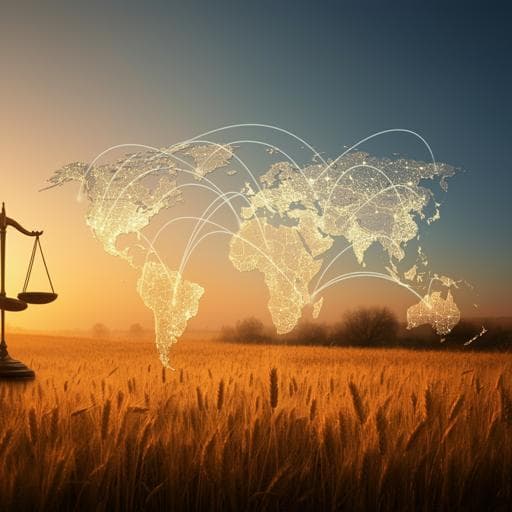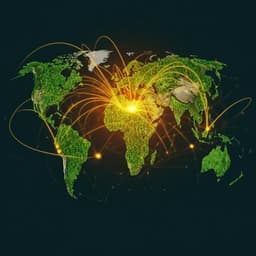
Agriculture
The Russia-Ukraine war decreases food affordability but could reduce global greenhouse gas emissions
H. V. Meijl, H. Bartelings, et al.
This groundbreaking scenario study by Hans van Meijl and colleagues explores the medium-term consequences of the Russia-Ukraine war on global agriculture. It reveals how rising food and energy prices impact low-income populations while assessing agricultural production's effects on biodiversity and greenhouse gas emissions.
~3 min • Beginner • English
Introduction
The paper examines how the Russia–Ukraine war affects global food security and the environment beyond immediate, short-term impacts. Ukraine and Russia are key exporters of wheat, maize, and sunflower products, supplying many low-income countries in the Middle East and Africa. The conflict, alongside rising energy and fertilizer prices, raises production costs and threatens harvests. The study’s research question is how medium-term (about two years post-invasion) shocks to production, trade, and energy markets transmit through the global economy to influence food availability, food access, land use, and GHG emissions. It emphasizes that food security is not only about availability but also access—requiring analysis of both prices and incomes. The authors adopt an integrated land–food–fertilizer–energy perspective to capture interactions between agriculture and energy, including the role of fertilizer markets, energy price shocks, land expansion, and associated biodiversity and emissions trade-offs. The work uses an economy-wide approach to capture circular income-expenditure flows and bilateral trade linkages, aiming to provide a holistic, medium-term global assessment while the conflict persists.
Literature Review
Prior analyses often focus on short-term or sector-specific impacts, net importers, or individual commodities, and typically emphasize availability rather than access. Studies using expert judgment or partial equilibrium frameworks may not capture economy-wide feedbacks. CGE models have been used for medium-term shock analysis (e.g., during COVID-19). Comparative references indicate that reduced exports from Ukraine/Russia can raise wheat and feed prices substantially; FAO estimates suggest 8–22% short-term increases and elevated prices for several years, while other studies (e.g., Carriquiry et al., Alexander et al.) highlight strong impacts from high energy and fertilizer prices and various price ranges for staples. The current study situates itself as providing a global, economy-wide CGE assessment integrating food, fertilizer, and energy markets, and including both availability and access metrics along with environmental outcomes.
Methodology
The study employs the MAGNET computable general equilibrium (CGE) model—an extension of GTAP—integrating global food, fertilizer (N, P, K), and energy markets with bilateral trade and circular income-expenditure flows. Key features include segmented agricultural vs. non-agricultural labor markets, endogenous land supply with heterogeneity and CET allocation across uses, and flexible nested CES production structures allowing substitution among inputs (including inter-fuel and energy–capital). Emissions accounting covers CO2, CH4, and N2O from combustion and non-combustion sources across all sectors, plus land-use change emissions. The model captures bioenergy sectors (first- and second-generation biofuels, biochemicals) and allows substitution from fossil to renewable energy. To reflect medium-term rigidity (≈5-year horizon), standard substitution elasticities between production factors—especially in agriculture, food, and energy—are reduced by 50% relative to default values. Food availability is measured as kcal per capita per day. Food access is represented by a food purchasing power index defined as the percentage change in wages for unskilled agricultural workers minus the percentage change in a cereal-based food basket (paddy rice, wheat, other grains), intended to proxy the diets of poorer households. Scenario design builds cumulatively: Scenario 1 (Ukraine impacts) comprises 1a: trade halt between Ukraine and Russia/Belarus (modeled via 90% effective tariff-equivalent); 1b: Ukraine macro and production losses—GDP down 33% (operationalized via 30% reductions in labor and capital, 50% reduction in land yields, and 10% population decline); 1c: additional 20% transport cost increases for Ukraine’s exports to the rest of the world. Scenario 2 (Ukraine + Russia impacts) adds Western sanctions on Russia with 90% tariff equivalents on targeted sectors; Russian real GDP down about 10%; and reduced Russian exports of wheat, other grains, and oilseeds by 50% (modeled via higher trade costs), alongside assumed 20% increases in global coal, oil, and gas prices linked to the conflict. Scenario 3 (Ukraine, Russia, energy price impacts) explicitly incorporates the 20% fossil energy price increase; a sensitivity with a “double energy price” (≈40%) is explored. Fertilizer prices respond endogenously to energy price shocks (particularly nitrogen to gas). Model data draw on GTAP; MAGNET documentation and supplementary materials detail parameterization and emissions/land-use coefficients.
Key Findings
- Macroeconomic impacts: GDP falls sharply in Ukraine (~−33%) and Russia (~−11%) in 2022–2024; elsewhere impacts are modest, with Central Asia around −0.5%. Energy price increases (Scenario 3) drive the largest GDP declines beyond the warring countries.
- Production: Losses in Ukraine/Russia are partly offset by increased output elsewhere in response to higher prices. In Scenario 3, production increases roughly 1% in Asia/Oceania up to ~11% in Rest of Africa; many regions rise 5–8% (e.g., EU, North America, Middle/South America, Middle East, Central/North Africa). Oilseeds production rises in several regions due to higher demand for non-food uses (biofuels).
- World market prices: Global prices rise for wheat (+9.2%), other cereals incl. maize (+8.4%), and oilseeds (+5.0%). Ukraine’s output and export declines alone add about +2% (wheat) and +4% (other grains); oilseeds increase more modestly (+1–3%). Russian export reductions further lift prices. A 20% fossil energy price increase adds ~3–4 percentage points to cereals and oilseeds due to higher energy/fertilizer costs and stronger bio-based demand. With doubled energy prices, wheat, other cereals, and oilseeds rise further (up to about +11%, +12%, and +8% additional, respectively, relative to lower-energy-price scenarios).
- Fertilizer prices: With a 20% gas/energy price increase, nitrogen fertilizer prices rise ~14%, while phosphorus and potassium increase ~4%. Under doubled energy prices, nitrogen rises to ~27%.
- Food availability: Declines in many low-income, import-reliant regions, notably Egypt, Turkey, and the Middle East. Europe changes are marginal (−0.2% in Scenario 1; −0.3% in Scenario 2). Under doubled energy prices, little change globally on average, with slight improvements for oil exporters (e.g., Middle East, Nigeria within SSA) and slight deterioration in South Africa and South/Southeast Asia.
- Food access: The food purchasing power index deteriorates by ~3–7% in many low- and middle-income countries under Scenario 3 (e.g., Egypt, Turkey, Rest of Central Asia), as cereal diet prices rise ~5–10% and outpace unskilled wage gains (0–4%). EU averages are less affected given lower food budget shares, though vulnerable low-income groups may face reduced access. Under doubled energy prices, the purchasing power index worsens by close to 10% in many countries.
- Land use: Ukraine’s production losses induce agricultural land expansion elsewhere. Scenario 1 leads to +6.2 Mha globally (notably Middle/South America and Rest of Africa). Scenario 2 yields a net global increase of ~+2 Mha (with land loss in Russia offset by expansion elsewhere). Scenario 3 results in ~+6.6 Mha globally, driven by higher prices and fertilizer cost-induced yield constraints; in the double energy price sensitivity, global agricultural land use increases by about +3 Mha.
- GHG emissions: Land-use change emissions increase by ~+0.6 Gt CO2e (Scenario 1), ~+0.2 Gt (Scenario 2), and ~+0.6 Gt (Scenario 3). Non-land-use emissions (from energy use, transport, manufacturing, and agriculture) are slightly negative in Scenarios 1–2 and decline by about −1.6 Gt CO2e globally in Scenario 3 (about two-thirds from production, one-third from consumption), with large reductions in fossil energy sectors (≈−0.62 Gt), transport (≈−0.45 Gt), and manufacturing (≈−0.04 Gt). Net global GHG emissions decline in Scenario 3 because the −1.6 Gt reduction outweighs +0.6 Gt land-use emissions (≈−1.0 Gt net). In the double energy price sensitivity, land-use emissions rise to ~+0.9 Gt while other emissions fall to ~−2.9 Gt, yielding nearly −2.0 Gt net reductions.
Discussion
The findings indicate that while global food availability can be maintained through supply responses and substitution, import-dependent low-income regions face worsened affordability due to higher cereal prices and limited capacity to expand domestic production. Food access erodes where unskilled wages lag behind staple price inflation. Currency depreciation can compound these pressures. Policy and market responses (e.g., Black Sea Grain Initiative, lifting of some export restrictions) helped temper early price spikes, but uncertainty about the conflict’s duration and logistics persists. Environmentally, the conflict drives agricultural land expansion—heightening biodiversity risks—yet higher fossil energy prices lead to substantial economy-wide energy savings and fuel switching, reducing non-land-use GHG emissions enough to offset added land-use emissions in aggregate. This highlights a complex trade-off: the war diminishes food affordability and raises biodiversity risk, but could yield net GHG reductions via lower fossil energy use. The results underscore the importance of integrated economy-wide modeling to capture food–fertilizer–energy linkages and the dual food security–climate implications of such shocks.
Conclusion
This study contributes an integrated, medium-term, global assessment of the Russia–Ukraine war’s impacts on food security and the environment using the MAGNET CGE model. It shows that: (1) global food availability is largely sustained by production increases elsewhere, but affordability deteriorates for many low- and middle-income, import-dependent populations; (2) agricultural land expands in land-abundant regions, elevating biodiversity risks; and (3) despite higher land-use emissions, total GHG emissions can decline due to significant reductions in fossil energy use triggered by higher energy prices. Policy recommendations include short-run donor support to improve access to substitutes for wheat and cereals in vulnerable countries; investments in infrastructure, drought-resilient alternatives, and diversification to build resilience; and income support or safety nets to protect food access, particularly where fiscal capacity permits. Future research should combine CGE analysis with household-level microsimulation to better capture access and distributional impacts, integrate spatially explicit land-use and biodiversity models for environmental detail, and develop country case studies to reflect heterogeneity and constraints (e.g., water scarcity, droughts).
Limitations
The analysis is medium-term and comparative-static, assuming markets reach new equilibria with rational agent behavior; it does not capture short-term rigidities or dynamic long-run developments. Results depend on uncertain assumptions about war duration, severity of production/logistics disruptions, and trade policy responses. Energy and fertilizer price pass-throughs vary by region and policy; gas prices are local and tax-dependent. The food security assessment includes availability and access (via a proxy purchasing power index) but omits utilization and stability dimensions and lacks explicit household heterogeneity—potentially understating access problems for specific groups. Environmental impacts would benefit from coupling with spatially explicit land-use and biodiversity models. Exogenous shocks like droughts (e.g., in major producers) could amplify food price effects beyond those modeled.
Related Publications
Explore these studies to deepen your understanding of the subject.







